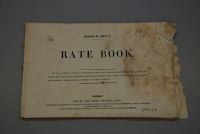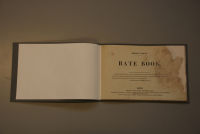In England and Wales, under the 1601 Poor Law Act, the payment of taxes by parish householders was used to provide funds for the parish poor.
Early rates were recorded on parchment or in books and generally only give a name, the rent they paid and the poor rate they were assessed at. However, after the Poor Law Amendment Act of 1834, printed books became available recording additional information. They provide important research material for house and family historians as they name the occupier (and sometimes the owner) of the listed property, as well as the amount assessed.
These important records are stored, along with the other archives at the Surrey History Centre, in climatic controlled strong rooms to ensure they are preserved and accessible into the future.
 Case study: Horsell poor rate books, 1851 to 1852
Case study: Horsell poor rate books, 1851 to 1852
(references 6198/11/56 and 6198/11/57)
Unfortunately, these two Horsell poor rate books had previously been stored under poor conditions where they became wet over a period of time, mould developed, and the pages became stained, weak and fragmentary. They arrived in such poor condition that it was impossible to allow access, as this would have caused further damage and loss of information.
Localised lamination was the method of repair chosen by the conservation team at Surrey History Centre to strengthen the fragile papers of the two books. This is a process of attaching shaped pieces of fine tissue with good transparency or clarity, coated with a clear acrylic adhesive to the damaged area. The coating of adhesive is normally activated by heat and pressure.
 Documents selected for treatment are carefully assessed to decide the appropriate conservation process. All processes, including lamination, must maintain the integrity of the document wherever possible; this means preserving the physical and visual character of the documents. Before the rate book pages were repaired, they were cleaned of any surface mould and dirt deposits. Any water-soluble stains and acids inherent in some papers were removed by washing in water baths.
Documents selected for treatment are carefully assessed to decide the appropriate conservation process. All processes, including lamination, must maintain the integrity of the document wherever possible; this means preserving the physical and visual character of the documents. Before the rate book pages were repaired, they were cleaned of any surface mould and dirt deposits. Any water-soluble stains and acids inherent in some papers were removed by washing in water baths.
Following this treatment, the repaired poor rate books were given new covers and are now available for consultation in our search room.

